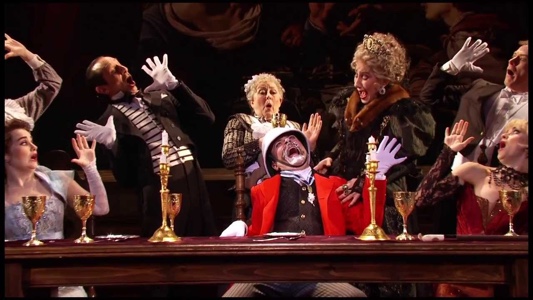Romping through 1900 London with a Murderous but Lovable Gentleman

Monty Navarro has just learned from an old friend of his mother’s that he is an heir in the D’Ysquith family and in line to become a British Earl, with all the money, castles and lands that brings. That does not please him, though. He wants to the Earl himself, right now, and since the Earl, and all of those next in line are quite healthy, Monty puts together a scheme to murder all of them to gain the title. The mob in America could not have come up with a better plan. He dashes off, singing and dancing his way through 1900 England, to accomplish his task. Along the way there are nefarious plots, entanglements with two women, one lustier than the other, marvelous songs and stellar plot twists in a delightful and very unique musical, A Gentleman’s Guide to Love & Murder, about the dawn of the 20th century in merry olde England
When you see the play you are thunderstruck at how clever playwright Robert L. Freedman was in constructing it. A Gentleman’s Guide is, at the same time, a sturdy detective story, romance, parade through the halls of the upper class and a huge game board of capers, one grander than the last that Monty pulls off to populate the local cemetery and achieve his goal. No one knows what he is doing or how he is doing it. Or do they?
A Gentleman’s Guide opened just over a year ago and won the Tony Award as Best Musical (it won several Tonys). I finally caught up with it at the Walter Kerr Theater in New York, and was stunned at how different, how wonderfully unusual, the play is. If you needed a guide to love and murder, or a guide to great entertainment, this splendid, uproarious musical is it.
The play hits the road in September for a national tour. Early tour dates are Schenectady, N.Y., Sept. 19-26, Chicago, Sept. 29-Oct. 11, Durham, N.C., Oct. 13-18, Tampa, Fla, Oct. 20-25, Lincoln, Nebraska, Oct. 29-Nov. 1 and Cleveland, Ohio, Nov. 3-15.
The music in the play, by Steven Lutvak, is very pleasing, and would accompany the book nicely in any normal, successful story. What makes the play so superb is the twisting, serial killer style plot that takes Monty through a long list of fatal scenarios, never blinking an eye as he murders, or arranges for the murder, of the entire family, his eyes always on the prize. It is a devious, ever evolving plot, full of trickery and chicanery, and you just cannot wait to see how Monty finishes off each of his victims.
Added to all of that is the fact that every victim, man and woman, each different and very singular, is played by the same actor, multi-talented Jefferson Mays. He is a frazzled bee keeper, military man, playboy, ice skater, old codger and, best, every one of the exaggerated women in the hunt. The audience just gasps every time he saunters out on stage in some new, and thoroughly outlandish, outfit.
Monty, played brilliantly by Jeff Kready, moves from victim to victim, moving back again if he did not finish them off the first time. He knows no fear, knows no defeat and knows no morality, and marches on in the name of the quest, his Earldom.
Gentleman’s Guide, the kind of musical the Marx Brothers would stage if they were around today, is a wacky, wonderful journey.
It is an historian’s Alice in Wonderland, too, because of all it covers in British history. You learn about early 20th century high society, British lordships, parties, teas, manor hoses, the Boer War, army life, 1900s fashion, corporate life and, well, bee keeping. You completely expect both Charles Dickens and Sherlock Homes to drop in, and if they did Jefferson Mays would play them, too.
The best scene in the play, perhaps on Broadway in the last year, is one in which Monty’s two women, blonde Sibella and brunette Phoebe, are after him. Sibella is in his bedroom when Phoebe arrives unexpectedly to tell him how much she loves him. Monty keeps Sibella in the bedroom, leaning up against the door in a dozen ways, and Phoebe in the living room, behind a second door. He races back and forth between the two women and the two doors. Phoebe does know the blonde is in the bedroom and the blonde, who does see the brunette, can’t get at her with whatever weapon she can fine.
In the end, after a long line of burials, it appears that Monty’s long run of treachery is about to pay off. He finally meets Albert, the last road block to the Earldom, and concocts a devious plan to kill him while avoiding the evil eye of his tempestuous wife.
Does he kill him and reach his beloved Earldom and its riches? Does he win the hand of the blonde or the brunette? Read the last page of the Guide…
PRODUCTION; The play is superbly directed by Darko Tresnjak. The play is produced by the Hartford Stage, the Old Globe, Joey Parnes, Sue Wagner, John Johnson, others. Scenic Design: Alexander Dodge, Costumes: Linda Cho, Lighting: Philip S. Rosenberg, Sound: Dan Moses Schreier. The play’s run is open ended.